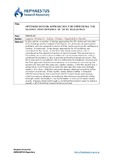| dc.contributor.author | Lagaros, Nikolaos D. | |
| dc.contributor.author | Bakas, Nikolaos | |
| dc.contributor.author | Papadrakakis, Manolis | |
| dc.date.accessioned | 2015-12-04T12:46:17Z | |
| dc.date.available | 2015-12-04T12:46:17Z | |
| dc.date.issued | 2009-03-28 | |
| dc.identifier.issn | 1559-808X | |
| dc.identifier.uri | http://hdl.handle.net/11728/50 | |
| dc.description | In this article, a number of design approaches for 3D reinforced concrete (RC) buildings are
formulated in the framework of structural optimization problems and are assessed in terms of
their performance under earthquake loading. In particular, three design approaches for RC
buildings are considered in this study. In the first, the initial construction cost is considered
as the objective function to be minimized. The second one is formulated as a minimization
problem of the torsional response, while a combined formulation is also examined as the .. | en_UK |
| dc.description.abstract | In this article, a number of design approaches for 3D reinforced concrete (RC) buildings are formulated in the framework of structural optimization problems and are assessed in terms of their performance under earthquake loading. In particular, three design approaches for RC buildings are considered in this study. In the first, the initial construction cost is considered as the objective function to be minimized. The second one is formulated as a minimization problem of the torsional response, while a combined formulation is also examined as the third design approach. The third approach is considered with two distinctive formulations. According to the first approach, the torsional behavior is minimized by minimizing the eccentricity between the mass and rigidity centers, while the second one is achieved by minimizing the eccentricity between the mass and strength centers. It is shown that the optimized designs obtained according to the minimum eccentricity of the rigidity center behave better in frequent (50/50 hazard level) and occasional (10/50 hazard level) earthquakes, while the designs obtained according to the minimum eccentricity of the strength center formulation was found better in rare (2/50 hazard level) events. Designs obtained through a combined formulation seem to behave equally well in the three hazard levels examined. | en_UK |
| dc.language.iso | en | en_UK |
| dc.publisher | Taylor & Francis | en_UK |
| dc.relation.ispartofseries | Journal of Earthquake Engineering; | |
| dc.rights.uri | http://creativecommons.org/licenses/by-nc-nd/4.0/ | en_UK |
| dc.source.uri | 10.1080/13632460802598594 | en_UK |
| dc.subject | Optimum Design of RC Buildings | en_UK |
| dc.subject | Life-Cycle Cost | en_UK |
| dc.subject | Minimum Torsional Response | en_UK |
| dc.subject | Limit State Fragility Analysis | en_UK |
| dc.title | Optimum Design Approaches for Improving the Seismic Performance of 3D RC Buildings | en_UK |
| dc.type | Article | en_UK |


